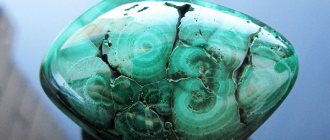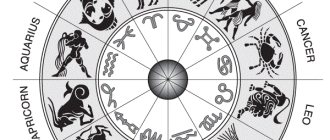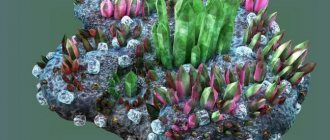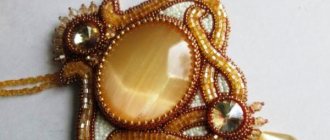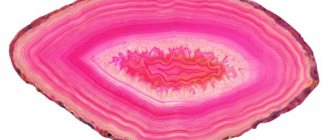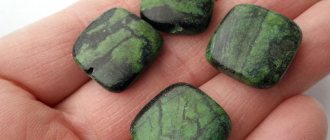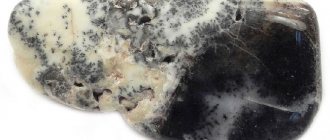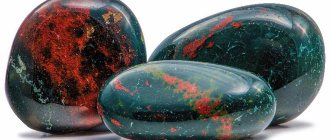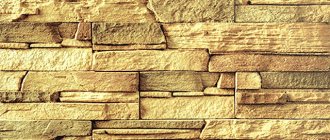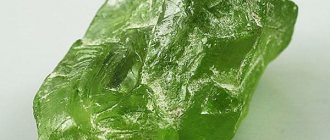The stone known as malachite occupies a special place among the five thousand minerals registered by science. The Russian gem has become famous all over the world not only for its rich green color and fancy graphics. The mineral is also used in healing, decoration and, of course, in the production of jewelry.
What malachite consists of and what it is used for, read our article.
The name "malachite": origin
The roots of the word “malachite” go back to the Greek language. There are two versions of the interpretation of this noun. According to one, the Greeks called the stone this way because of its rich color - μολόχα - “green flower”. Another version says that the name comes from the word μαλακός - “soft”.
Indeed, malachite is distinguished by its fragility; it is unstable to external influences. Jewelers claim that real Ural malachite loses color and becomes dull, even if dust just sits on it! It is noted that the softness of this mineral can also turn into its advantage. After all, malachite lends itself well to polishing and grinding.
Physicochemical characteristics
Malachite is a complex copper carbonate. Contains copper oxide, water and carbon dioxide, with copper up to 57% in the composition. It is copper that gives the characteristic green color. Iron acts as an impurity that provides additional shades.
The old name of the mineral is “carbonic copper greens.” It was applied to crushed, powdered malachite.
Hardness - up to 4 Mohs units. Slightly higher than that of pure gold and silver (without jewelry additives). The main Ural gem is inferior in hardness to glass; it is easily scratched with a steel knife, but with difficulty with a copper one.
The structure is crystalline, the crystal structure is needle-like, lamellar or prismatic. When subjected to mechanical action, the crystals split, forming spheroid or dendroid shapes (similar to balls or dried trees).
| Formula | Cu2CO3(OH)2 |
| Color | Green |
| Shine | Matte, in large quantities - silky, in crystalline form - glassy |
| Transparency | Opaque |
| Hardness | 3,5 — 4 |
| Cleavage | Perfect |
| Kink | Shellish, splintered |
| Density | 3.75 - 3.95 g/cm³ |
History of the stone
The oldest malachite jewelry was found in Iraq 10.5 thousand years ago. And in Israel, malachite beads were found that are nine thousand years old. In Ancient Rome, malachite was used to create amulets and amulets. This mineral was extremely popular in China and India. In addition, it was used to make paints that did not lose their brightness for a long time. Proof of this are the tombs of the pharaohs. And beauties from Ancient Egypt made eye shadow from malachite powder.
Application area
Prices for malachite are low, about $5 per gram. It is mainly used as an ornamental stone - it is cut or split into thin plates, which are used to cover flat or voluminous large objects - boxes, vases, chests, tabletops, and so on.
Malachite jewelry
Large blocks are used entirely. Souvenirs are made from them - amulets and talismans in the form of balls, pyramids, and animal figurines. For the needs of handicrafts, they produce faceted and polished beads of various shapes and sizes - round, pear-shaped, leaf-shaped, etc., from which home craftsmen make designer jewelry. At the same time, the cost of malachite increases significantly.
Ural malachite: history of fishing in Russia
Until the 18th century, malachite was found only in the form of small nuggets. This mineral became popular only after the development of the Ural deposits began in Russia. It was Russian miners who were able to find blocks of the mineral that weighed several hundred tons. But the heaviest block weighed 250 tons. It was discovered in 1835.
The first malachite deposit was discovered in the forties of the 18th century. It is called Gumeshevskoe and is located at the source of the Chusovaya River. Thanks to the opening of that mine, the production of small jewelry began in Russia. Rings and beads, earrings and pendants - the Ural malachite stone was usually used together with other stones, most often precious.
The flourishing of the fishery began after the discovery of the Mednorudnya deposit. It was then that a unique style of making products from this stone appeared, which was called Russian mosaic. Skilled stone cutters sawed the stones into the thinnest plates, selected patterns and glued them onto the base. Then the grinding process began. Russian craftsmen created such Ural products from malachite that not a single observer could even doubt the solidity of the products.
The reserves of Ural malachite were so rich that some craftsmen could afford to handle this mineral carelessly. There are known cases when malachite chips, which craftsmen refused to work with, were used to fill up holes in pavements. Today, such extravagance seems like real madness, because even the smallest samples are a real miracle.
The year 1726 was marked by the appearance of the first malachite processing workshop in the Urals. And in 1765, by decree of Catherine the First, the first factory of Ural malachite was opened - the Yekaterinburg Lapidary Factory. It was at the same time a complex for the extraction and processing of this stone, a center for stone cutting and an educational institution for several generations of craftsmen.
Varieties
When classifying malachite, the pattern, design and texture are taken into account. Some stones are only suitable for copper mining, but other specimens are quite interesting and can be used for jewelry.
This table will help you understand the groups:
| Name | Description |
Kinds:
|
|
Pseudomorphoses, aggregates, compounds with other minerals:
|
|
Plush
Nodular
Radiant
Pseudomalachite
Atakamite
Chrysocolla
Aurichalcite
Cuprite
Native copper
The mineral composition is similar to malachite. Often they grow together and represent monolithic original specimens.
They are used for the manufacture of decorative items in a single copy, which are especially highly valued.
Malachite + other rocks
After joining, crystals are obtained, which include several gems:
Calcite – malachite
It is a mixture consisting of gypsum, malachite and calcite.
Azurmalachite
One of the most popular combinations, characterized by an interesting greenish-blue tint. Both elements grow together to form one crystal.
Star malachite
Chalcedony is interspersed with round-shaped malachite spots.
Agate – malachite
The latter is expressed by spots of a greenish tone and looks beautiful in the overall structure of jasper.
Eilat stone
A combination of 3 minerals: malachite, chrysocolla and azurite. The stone has a dark, rich green color with bluish inclusions.
Lapis - malachite
This is a duet of quartz and malachite.
Mysoreen
An original gem combining malachite, chrysocolla and calcite.
There is also pressed malachite, which is obtained artificially: small pieces are combined into a single stone using technologies that use high pressure.
Pressed malachite
Popularity of the mineral
This stone became a decoration for the houses of Russian and European nobility. It was even used for cladding rooms, for example, the Malachite Living Room of the Winter Palace. The artistic value of this masterpiece of Russian architecture is difficult to overestimate. The pattern is chosen so skillfully that the joints between the plates are completely impossible to see. The columns of St. Isaac's Cathedral were also lined with malachite. In the chambers of wealthy people one could find such items as a vase made of Ural malachite, watches, snuff boxes, caskets, and even fireplaces and tabletops made of this mineral.
By the way, at that time it was very fashionable to collect interesting samples of various minerals, including malachite. The nobility even competed with each other. Empress Catherine II rightfully received the title of owner of the best collection.
Who is it suitable for?
Esotericists recommend wearing malachite:
- artists;
- poets;
- writers;
- artists;
- scientists;
- doctors.
Zodiac signs
Libra - nature created this stone for you. Taurus and Capricorn will receive full magical and healing help from the gem.
Malachite is not very suitable for Cancers, Scorpios, and Virgos. Treatment with the mineral is acceptable for them.
The rest of the zodiac signs can wear jewelry with a green gem as decoration and for magical purposes.
Is Malachite right for you?
Not really
Element
Earth
Planets
Moon
Saturn
Energy
Yin
Types of malachite
There are two types of Ural malachite - plush and turquoise. Plush malachite is fragile and therefore less amenable to processing. It is not used to create jewelry. Most often, this species is of interest to mineralogists. Amateurs and experts collect samples of this mineral. The more common type of malachite is turquoise. Its structure is unique: a bizarre pattern is created by asymmetrical stripes and circles. Unique green patterns are valued by both collectors and jewelers.
The end of the malachite era
At the end of the 19th century, this delightful mineral became available not only to very wealthy people, but also to nobles. Competitions regarding the number of malachite items in homes have ceased, and the mineral has become less used in interiors. Malachite began to be used to make paint that covered the roofs of houses.
The revolution of 1917 led to the fact that stone mining decreased significantly. This was due to the fact that the two main deposits - Mednorudnyanskoye and Gumeshevskoye - were severely depleted. At the end of the 19th century, the Gumeshevskaya mine was seriously flooded. That’s why now this place is visited exclusively by extreme sports enthusiasts. The Mednorudnyanskoe deposit is still functioning, but it is not malachite that is mined here, but copper ore. Today, Ural malachite is practically never found here, and therefore is valued more and more.
Malachite case today
The Urals are far from the only place in the world where malachite deposits have been discovered. Development is also underway in Altai. By the way, sometimes there are samples of Altai malachite, which in terms of beauty and fancy rings are practically no different from samples of the Ural mineral. The modern leader in the supply of malachite is the Republic of Congo. The malachite mined here differs from the Ural one in its pattern, consisting of even stripes. The mineral is mined in the UK, Chile, Australia, France and Cuba. However, the stones mined in these mines are significantly inferior in their external qualities to Ural malachite.
Field
Previously, malachite was mined in huge quantities in Russia (until 1917). Now the reserves are almost exhausted; small amounts of mining remain on Lake Baikal.
Gemstones from the Korovinsko-Reshetnikovskoe deposit and Altai are also supplied.
The most active production and export is carried out in the Congo. The stones from there have a characteristic bright pattern and cylindrical design.
There are several other deposits in the world, but not so large:
- France;
- Germany;
- Kazakhstan;
- England (County Cornwall);
- Australia;
- Italy;
- Namibia;
- Chile.
African malachite
African malachite has bright shades and alternating light and dark stripes of green color, which makes the stone original with a spectacular color scheme.
Does malachite from the Urals have a future?
Experts have found that all the world's reserves of malachite can be classified as one type, and the appearance of the mineral is associated with the zonal oxidation of copper ores. That is, the likelihood that new malachite deposits can be found in the Urals is extremely high.
For several years, Grigory Nikolaevich Vertushkov, a professor at Sverdlovsk University, has been collecting information that is somehow related to copper and malachite deposits. He is sure that the researchers were mistaken and in fact the reserves of the Ural mines are not depleted. Grigory Nikolaevich claims that in two deposits deep reserves of this unique mineral have not been touched.
Magic and astrology
Green stones were considered a talisman and a talisman; they were credited with a lot of properties that helped ordinary people cope with the hardships of life.
Sorcerers and magicians claimed that malachite would help:
- Become invisible.
- Will save you from fears and nightmares.
- Will help a woman get rid of her pregnancy.
- Makes a person believe in his own strength.
- It will calm and give harmony.
There are a huge number of legends that say that a mineral from the Ural Mountains can make a person invisible. It gives the owner the ability to disappear and appear in the right place at one time or another. In order to gain this gift, it is worth coming into contact with malachite and establishing a relationship with it.
Cups made of Ural malachite
The mineral was used as a talisman for children and adults. They tied him to the cradle, believing that malachite would protect the child. It will help your baby fall asleep and not suffer from nightmares and bad dreams at night. But an adult should put a stone under their pillow - it will help cope with insomnia and relieve anxiety and fears.
Healers recommended pregnant women to wear malachite beads. This stone was used during childbirth to ensure that a woman gave birth to a healthy baby and lost less blood. After birth, a cross made of this mineral was immediately put on the baby; it was considered a powerful talisman.
They say that a green stone helps to gain self-confidence. It forces a person to strive for a goal, achieve the desired result and overcome difficulties. This ability was in great demand among the population. They believed that malachite would certainly bring success and protect against failures and accidents.
Today the mineral is used as an element in spiritual practices. You can meditate on malachite; it makes sense to place the stone nearby - it will help you find harmony. The reason for everything is the color of the mineral, which gives a person peace of mind and helps to achieve enlightenment.
But malachite also has one more interesting feature - it attracts ill-wishers. When communicating with new people, you should be careful. The stone can attract envious people, but it will be difficult to recognize the ill-wisher.
Malachite absorbs the bad thoughts of other people and becomes dangerous. For this reason, the mineral needs to rest from time to time. To return the stone to its original properties, you should put it in a box, close the lid and do not touch it for several days.
According to astrologers, green stones have favorites; they favor certain zodiac signs.
Malachite from the Urals is suitable:
- Capricorns.
- Libra.
- Taurus.
The green color of the mineral carries the energy of the Earth - for this reason it is suitable for Capricorns. Representatives of this zodiac sign are calm and reasonable. But despite this, Capricorns are stubborn and prone to despondency; they are so fixated on achieving the goal that they sometimes lose sight of the main thing. Malachite will help Capricorns cope with melancholy and teach representatives of this zodiac sign to rejoice.
Malachite will help Libra overcome self-doubt. Representatives of this zodiac sign doubt everything: they question their own attractiveness, decisions made, and even obvious things. A green stone will help Libra make the right decision and no longer hesitate.
As for Taurus, representatives of this zodiac sign are fixated on material well-being. Taurus people love money and know how to spend it. So, jewelry with a stone will help representatives of this zodiac sign achieve material well-being, increase profits and find a goal. It should be worn regularly on your left hand.
But this mineral will not benefit Cancers and Scorpios. For this reason, representatives of these zodiac signs should admire malachite from afar.
Scorpios are distinguished by powerful energy; they are not able to obey the stone. For this reason, malachite will not help them. The mineral will change the character of Scorpio, making him harmful and irritable.
Cancers are highly emotional, creative and ambitious. Despite these qualities, they should not ask malachite for help. This stone will make Cancer nervous and push him to commit rash acts.
Ural malachite will not cause harm to everyone else, but there will be no benefit from it either. Jewelry with this mineral should not be worn regularly. It is worth wearing the products 2-3 times a week.
The most famous malachite products
The Malachite Hall mentioned above is simply a treasure trove of products made from this mineral. Here you can see vases and tables, bowls and columns. Everything took about two hundred poods (by the way, 1 pood is 16.38 kg). Almost all the products here are made in the “Russian mosaic” style. 1,500 pounds of malachite were needed to line the columns of the largest Orthodox church in St. Petersburg - St. Isaac's Cathedral.
In the Pitti Palace, located in Florence, there is a malachite table, preserved from the heyday of the malachite craft in Russia. An incredible collection of objects was made for the London Exhibition in 1851: doors, tables and chairs, grandfather clocks, vases and a fireplace.
How to distinguish real malachite from a fake?
Ural malachite, the photo of which you have already seen, is very popular, and therefore its synthetic analogue has appeared on the market. To create a fake, plastic and glass are used.
How to distinguish a natural stone from a fake?
- Real malachite is cool to the touch. Plastic imitation – warm.
- Glass stone is distinguished by the presence of transparent inclusions on the surface.
- Imitations, which are made on the basis of other stones with the addition of painting and varnish, can be distinguished from natural stone by dropping ammonia on them: real malachite will acquire a blue tint, but the fake will not change.
- You can also distinguish genuine Ural malachite from a fake using vinegar or lemon juice. True, the surface of a natural stone after such a check will begin to bubble strongly.
How to wear and care
Rings with “Ural green” are worn on the left hand, on the middle finger or on the little finger. Bracelets and beads - whatever you like, the requirements for wearing rules relate only to the need to protect malachite from shock. This is a fragile stone that can be easily scratched or chipped. He also does not like sudden temperature changes.
Malachite bracelet
If the stone is used in lithotherapy, then place it in the ground after each treatment session. Soil in a flower pot will do. Leave the stone in the ground overnight - in the morning it will be usable again. Change the soil in the “cleansing” pot every lunar month.
Magical and healing properties of Ural malachite
They began to endow the green mineral with magical properties back in the Middle Ages. Small pieces of malachite were hung over a baby's crib, in the belief that they would ward off evil spirits and the baby would sleep peacefully. To protect an adult, malachite was engraved, usually in the form of the sun.
It was believed that malachite was a good helper in love rituals. It was often mentioned in fortune telling and magic books as a means of attracting love and keeping it. Traditional healers used malachite to treat allergies and skin diseases, asthma and migraines.
Medicinal properties
Lithotherapists include the following medicinal properties of the Ural gem:
- normalization of an unstable emotional state;
- decreased blood pressure;
- relief of cramps in various diseases;
- relief of arthritis pain;
- relief of asthma attacks;
- in women - relief of pain during painful menstruation and childbirth.
Since malachite lowers blood pressure, it is not suitable for hypotensive patients!
Some experts even mention the fight against cancer among the healing properties of “Ural greens”. They claim that constantly carrying a large gem with you slows down the spread of metastases.
Malachite is a good object for meditation. If you look for a long time at the play and interpenetration of colors into each other on the surface of the stone, you can calm your nerves and smooth out aggression.
The lighter and brighter the stone, the higher its healing qualities. The abilities described above can be enhanced even more if you encase your specimen in copper.

